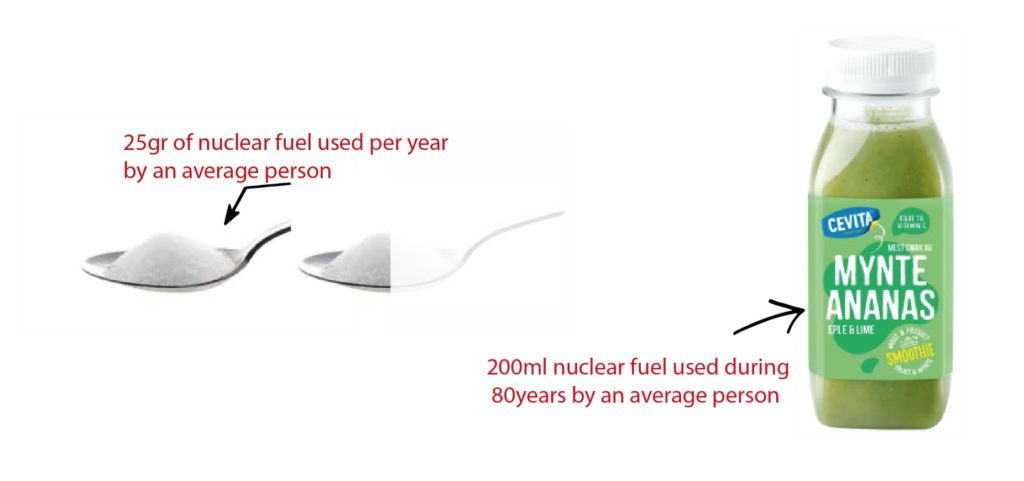An average person in Norway consumes about 7600 kWh of electricity per year related to the household consumption [1]. Considering a life expectancy of 80 years, a person will use about 608 MWh of electricity during the lifetime in terms of household consumption.
The enormous energy density of U235
The uranium isotope U235 [2, 3] has an enormous energy density. For example, one kg of gasoline allows to drive a car about 20 km whereas 1 kg of U235 would allow to drive a distance equivalent to the distance from earth to the moon and back at least twice. A 1000 MWe nuclear power plant consumes about 3 kg of U235 per day, while one 1000 MWe coal power plant consumes 9 000 000 kg of coal per day.
How much nuclear fuel does one person use per year and during his life?
A 1000 MWe nuclear reactor consumes about 27 tonns of nuclear fuel containing U238 with few percent of U235 per year [4,5]. Then, based on the average electricity consumption per person in Norway as described above, a person needs about 25 g of nuclear fuel per year for generating 7 600 kWh. Or about 2 kg of nuclear fuel with a volume of 200 ml during a period of 80 years.
So the lifetime of electricity of a person has a volume no larger than a bottle of smoothie.

Energy, power, energy density and power density
In energy generation, four concepts are important, namely (i) energy as the ability to do work, (ii) power as the rate at which work gets done meaning energy produced over time, (iii) energy density as the amount of energy stored in a given system, substance, or region of space per unit, and (iv) power density as the rate of energy flow that can be generated or harnessed per unit of volume, time or mass.
For example, oil contains energy in the form of chemical bonds, U235 contains energy in the form of nuclear bonds, and water in a water magazine in the form of potential energy. The energy density of U235 is 79 390 000 MJ/kg, for oil is 42 MJ/kg while the specific energy of water falling 100 m is 0.0098 MJ/kg. This implies that burning U235 will produce 1 890 000 more power than the same mass of oil at the same burning rate. Burning 1 kg of U235 is equivalent to let 8 100 000 000 kg of water fall 100 m during the same period. The higher the energy density, the lower the use of the energy source.
The importance of the power density in the minimization of resources
All form of electric energy generation require a power-generation machinery which uses resources [6] and has an operational lifetime. This power-generation machinery is required no matter if a fuel is used or not as energy source. The energy density of the energy source defines the characteristics and size of the machinery and the resources required for constructing the machinery.
The power-generation machinery for burning 1 kg of U235 is much more compact than a machinery for gathering and processing 1 890 000 kg of oil, or for gathering and managing 8 100 000 000 kg of water for producing the same power. These resources [7], independent if a fuel is used or not, are from concrete and steel to critical materials and mineralsm[6] which require mining, processing, and transport of tons of material.
So, the higher the power density of the power-generation machinery, the lower the use of resources. For this reason, other energy generation alternatives to nuclear power require at least from 10 to 100 times more material use per kWh, and 10 to 1000 times more area use per kW, and even more when considered the additional storage systems, backup systems, overcapacity installation and grid extensions required and part of intermittent-distributed energy source systems [8].
Electricity generation is similar to strawberry production
All the discussions about energy generation can be very complicated to follow with strange acronyms, metrics, and frameworks. Let us assume that we want to sell strawberries. One option is to use a small area of land to cultivate, process, and distribute the strawberries to the market. This will allow to have a controllable and reliable production.
Another option can be to take the strawberries from the forest. However, this will add costs of transportation to remote locations, extra labor for finding and picking up the strawberries and create areas of gathering and add extra transport to the costumers. This approach based on distributed strawberries will be unreliable, with limited control and scalability of the production, higher costs, and impact on the forest.
The first option represents high energy-density energy sources and high power-density systems producing a high number of strawberries per square meter and minimum use of resources. The second option are low energy-density sources and low power-density systems producing a small number of strawberries per square meter with a larger costs and resource impact. Salmon farming provides a similar example. These is why we were not collecting strawberries from the forest or salmon from the open sea.
The lower is the energy density of the energy source, the larger is the use of resources. This causes a transition from fuel-intensive to a material-intensive energy system which contradicts the purpose of the low energy density systems in terms of use of resources and environmental impact. A nuclear power plant produces 1000 MWe, uses about two squares kilometers and last for about 60 years. Based on this system, a person during their lifetime will use a small amount of nuclear fuel not larger than a small bottle of smoothie. However, from this spent nuclear fuel, 96 % is still nuclear fuel that can be recycled.
Note: the estimations discussed are based on several assumptions and considerations. The estimations are based on the operation conditions for AP1000 nuclear reactors.
References
- Energy consumption in households in Norway. Statistisk sentralbyrå. https://www.ssb.no/435431/energy-consumption-in-households-in-norway.gwh-kwh
- What is Uranium? International Atomic Energy Agency https://www.iaea.org/newscenter/news/what-is-uranium
- All about uranium. Orano group. https://www.orano.group/en/unpacking-nuclear/all-about-uranium
- Status report 81. Advance passive PWR (AP1000). https://aris.iaea.org/PDF/AP1000.pdf
- Westinghouse AP1000 Design Control Document. https://www.nrc.gov/docs/ML0715/ML071580895.pdf
- Mineral Requirements for Electricity Generation. https://www.world-nuclear.org/information-library/energy-and-the-environment/mineral-requirements-for-electricity-generation.aspx
- The Role of Critical Minerals in Clean Energy Transitions. International Energy Agency. https://iea.blob.core.windows.net/assets/ffd2a83b-8c30-4e9d-980a-52b6d9a86fdc/TheRoleofCriticalMineralsinCleanEnergyTransitions.pdf
- Renewable Energy and Electricity. https://world-nuclear.org/information-library/energy-and-the-environment/renewable-energy-and-electricity.aspx
Further reading
- Your lifetime used fuel would fit in a soda can! Want proof?
https://cna.ca/2019/06/25/your-lifetime-used-fuel-would-fit-in-a-soda-can-want-proof/ - Take a virtual tour inside the Dukovany nuclear power plant, Czech Republic. https://www.cez.cz/en/energy-generation/nuclear-power-plants/dukovany
- Westinghouse Nuclear: https://www.westinghousenuclear.com/
About

Carlos Alberto Dorao is Professor at NTNU – Department of Energy and Process Engineering. He has an engineering degree in Nuclear Engineering from Balseiro Institute, Argentina, and a PhD degree in Chemical Engineering from NTNU. He as amongst others worked as a researcher at the Bariloche Atomic Center, Argentina in the early 2000’s.


